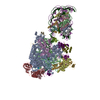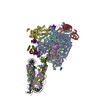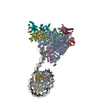+Search query
-Structure paper
| Title | Structural Basis of Damaged Nucleotide Recognition by Transcribing RNA Polymerase II in the Nucleosome. |
|---|---|
| Journal, issue, pages | J Mol Biol, Vol. 435, Issue 13, Page 168130, Year 2023 |
| Publish date | Jul 1, 2023 |
 Authors Authors | Ken Osumi / Tomoya Kujirai / Haruhiko Ehara / Mitsuo Ogasawara / Chiaki Kinoshita / Mika Saotome / Wataru Kagawa / Shun-Ichi Sekine / Yoshimasa Takizawa / Hitoshi Kurumizaka /  |
| PubMed Abstract | In transcription-coupled repair (TCR), transcribing RNA polymerase II (RNAPII) stalls at a DNA lesion and recruits TCR proteins to the damaged site. However, the mechanism by which RNAPII recognizes ...In transcription-coupled repair (TCR), transcribing RNA polymerase II (RNAPII) stalls at a DNA lesion and recruits TCR proteins to the damaged site. However, the mechanism by which RNAPII recognizes a DNA lesion in the nucleosome remains enigmatic. In the present study, we inserted an apurinic/apyrimidinic DNA lesion analogue, tetrahydrofuran (THF), in the nucleosomal DNA, where RNAPII stalls at the SHL(-4), SHL(-3.5), and SHL(-3) positions, and determined the structures of these complexes by cryo-electron microscopy. In the RNAPII-nucleosome complex stalled at SHL(-3.5), the nucleosome orientation relative to RNAPII is quite different from those in the SHL(-4) and SHL(-3) complexes, which have nucleosome orientations similar to naturally paused RNAPII-nucleosome complexes. Furthermore, we found that an essential TCR protein, Rad26 (CSB), enhances the RNAPII processivity, and consequently augments the DNA damage recognition efficiency of RNAPII in the nucleosome. The cryo-EM structure of the Rad26-RNAPII-nucleosome complex revealed that Rad26 binds to the stalled RNAPII through a novel interface, which is completely different from those previously reported. These structures may provide important information to understand the mechanism by which RNAPII recognizes the nucleosomal DNA lesion and recruits TCR proteins to the stalled RNAPII on the nucleosome. |
 External links External links |  J Mol Biol / J Mol Biol /  PubMed:37120012 PubMed:37120012 |
| Methods | EM (single particle) |
| Resolution | 4.0 - 7.1 Å |
| Structure data | EMDB-32407, PDB-7wbv: EMDB-32408, PDB-7wbw: EMDB-32409, PDB-7wbx: EMDB-34685, PDB-8he5: |
| Chemicals |  ChemComp-ZN:  ChemComp-MG: |
| Source |
|
 Keywords Keywords |  TRANSCRIPTION / TRANSCRIPTION /  RNA / RNA /  DNA / DNA /  Repair Repair |
 Movie
Movie Controller
Controller Structure viewers
Structure viewers About Yorodumi Papers
About Yorodumi Papers











 komagataella phaffii (fungus)
komagataella phaffii (fungus)
